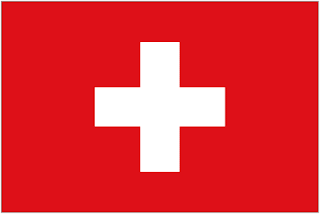The National Flag of Switzerland
The origins of the Swiss flag comes from 1 of 3 legends. 1 says that the white cross was from the Theban Legion who added a white cross to the formerly plain red battle flag. Another says that it was the Reichssturmfahne who added the cross, and the third states it was the Arma Christi, of the three forest cantons at the birth of the first Swiss confederation in the late 1280's. Apparently, they where allowed to place a white cross on their battle flag by King Rudolph I of Habsburg in 1289.
The oldest specimen of a flag of Schwyz that survives dates back to 1474, with a white cross placed in the upper hoist canton of a plain red banner.
However, the first recorded use of a white cross comes from the Old Swiss confederacy in 1339, when troops from the allied Swiss cantons sewed a cross onto their red battle clothing to contrast with the Habsburgs, who used the red cross of St George.
During the Napoleonic Wars, The Swiss confederation was a collection of cantons operating within a loose framework of rules, but largely independent. People tended to see themselves as from their canton first, and Swiss, if the Swiss confederation was under threat.
With the confederation collapsing due to in-fighting and political struggles, the French did not meet strong resistance as they moved in. Soon occupying the whole area, they abolished the cantons, and established a centralised Helvetic Republic. This Republic was the first time that everyone in the area was classified as Swiss first, and seen as a first step towards the federal republic of today. The flag that was created was a horizontal tricolour of green, red, and yellow. With the name of the republic written in yellow along the central red stripe.
Beset with problems, the Republic suffered from a financial crisis, as well as political infighting, and resistance. And in 1803 it finally collapsed, leading to the restoration of the Swiss confederation and the re-establishment of the cantons.
In 1815, the Geneva Congress saw the main powers of Europe restore Switzerland, and guarantee its neutrality. also, the white cross was chosen to represent the Swiss confederation. Then, in 1850, the cantons decided to merge into a federal state, with local issues still left to the cantons. However, this saw the Swiss flag being adopted to represent the Swiss in their entirety.
Switzerland is one of only 2 states in the world that use square flag. The other being the Vatican City. However, despite not having access to the sea, Switzerland does maintain a small force to police the lakes that lie on the borders with other nations. And for this water-based force, they use a rectangular red flag with a white cross.
In 1863, the International Red Cross came into being.
This organisation is based on the helping of people in medical need. The emblem is based on the Swiss flag, the country where it was started, and in honour of its founder, Henry Dunant. The IRC takes the Swiss flag, and inverts it. A Red Cross, on white.
However, with the Cross being a Christian symbol, in order to operate in the Arabic middle east, they use a red crescent.
In Israel, vehicles use a red star of David.
And because all of these a religious emblems, in order to try to create a new non-religious symbol that works anywhere, the IRC adopted a new red crystal emblem.
The white Cross of Switzerland is world famous for a nation that is strictly neutral, and has been used to adorn all sorts of fashionable things, and of course, the world-famous Swiss Army Knives!









No comments:
Post a Comment